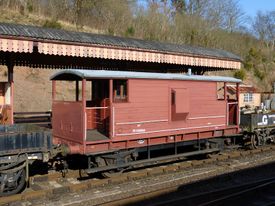LMS 730866 Goods Brake Van
| LMS 730866 Goods Brake Van | |
|---|---|
 LMS Brake Van 730866 at Bewdley (2015) | |
| Built By | LMS Derby |
| Status | Operational |
| Number | 730866 |
| Other Numbers | DM 730866 |
| History | |
| Built | 1940 |
| Diagram | D2036 |
| Lot | 1278 |
| Type | 20T Brake Van |
| TOPS code | CAP |
| Brakes | Through piped |
| 1990 | Entered preservation on SVR |
Contents
Contents
Service
730866 was built at Derby in 1940 as Lot 1278 to Diagram D2036.[2]. It also saw Departmental use, having carried the number DM 760866. Its working life ended at Radyr in south Wales. [1]
Preservation
Owning group the 2857 Society decided to purchase an LMS Brake Van and inspected a number before identifying 730866 as an example in good condition. It was purchased from BR for £800 and moved from Radyr by rail to the C&W Maintenance shops at Cathays, near Cardiff. From there it was transported by road to the SVR, arriving at Kidderminster on 17 February 1990.[3]
After arrival, 730866 was restored and repainted in LMS brown livery. It saw use in the SVR ‘Steam School’ during the 1990s, although this ended when it became a requirement to use a vacuum brake fitted vehicle. It remained in working order and used regularly in works trains. It has also been used to give brake van rides at galas and special events.
It also spent some time in The Engine House in BR(M) livery.[4]
In 2018 it was unfortunately 'red carded' for unsafe running boards before the Goods Gala on 2-3 June, where it was due to form part of the demonstration goods train hauled by 2857 to celebrate the locomotive's 100th anniversary. This inevitably turned in to a bigger job with the Wagon Department repairing handrail fixing points, the veranda floors and the step boards. The wagon also was repainted back into LMS condition.[5]